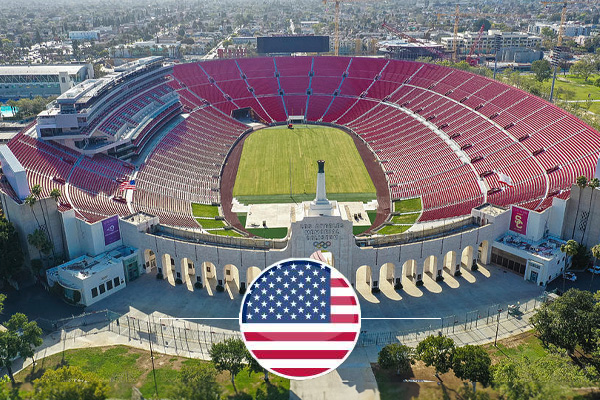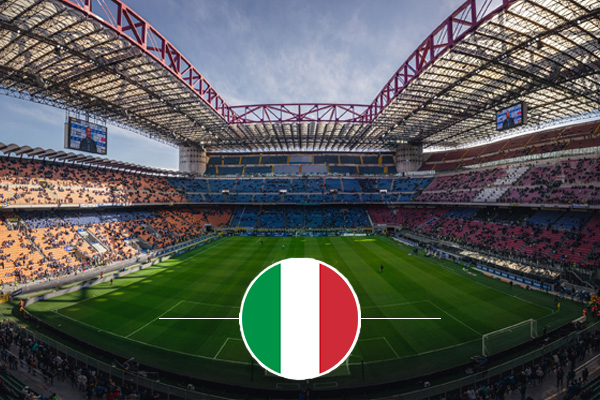Top 20 Biggest Football Stadiums
Answering your calls we decided to launch a permanent list of the largest stadiums around the world. To make the global Top 20, a stadium has to reach nearly 90,000 capacity (or 75,000+ for all-seaters).
Use the switch below to show two variations of the list: first one includes all football stadia regardless of the kind of seating. The second one presents only those offering 100% of individual seating.

-
 Bristol Motor Speedway (153,000)
Bristol Motor Speedway (153,000)Bristol, Tennessee, USA | It may be a racetrack on a daily basis, but it’s also the world’s largest sporting venue with fully enclosed stands. Temporarily used for football (as it used to be since 1960’s), it broke the all-time record for American football in 2016.
-
 Rungrado May Day Stadium (114,000)
Rungrado May Day Stadium (114,000)Pyongyang, North Korea | Built in 1989 for 150,000 people, and at peak holding 190,000 during a boeing match, this is the national stadium of North Korea. Based on the Rungrado islet, it was downscaled after conversion into an all-seater in 2014, but to this day remains the world’s largest stadium.
-
 Michigan Stadium (107,601)
Michigan Stadium (107,601)Ann Arbor, Michigan, USA | It would have hosted far fewer people if converted into all-seater, but the bleachers are part of its college atmosphere. Nicknamed “The Big House”, this is the world’s largest single-tiered stadium!
-
 Beaver Stadium (106,572)
Beaver Stadium (106,572)University Park, Pennsylvania, USA | When your seats are located in row 112, you can be sure that you’re entering a true giant! Beaver Stadium is expected to lose some capacity in upcoming years to increase comfort of fans, but should still be a 100,000-capacity ground.
-
 Ohio Stadium (102,780)
Ohio Stadium (102,780)Columbus, Ohio, USA | It’s famous for its decor, inspired by the Roman architecture. But let’s not kid ourselves, Ohio Stadium is famous worldwide for being above the 100,000-mark since 2001!
-
 Kyle Field (102,733)
Kyle Field (102,733)College Station, Texas, USA | It’s only been in the prestigious 100k+ group since 2014, but already manager to draw a crowd of over 110,000 inside. Kyle Field thus broke records for Texas collegiate attendance and breaking a record in Texas is not nothing as they have the most of world’s largest stadia!
-
 Tiger Stadium (102,321)
Tiger Stadium (102,321)Baton Rouge, Luisiana, USA | It’s hard to believe now that it was once only a 12,000-capacity stadium. Those days had passed in 1930s and since then a long series of over 20 expansions led to the monstrous size that we can admire.
-
 Neyland Stadium (101,915)
Neyland Stadium (101,915)Knoxville, Tennessee, USA | It’s a rare case in the US to see a stadium that big with a very uniform and continuous appearance throughout the seating bowl. In Tennessee it was a achieved by a series of expansions that hoped to cope with immense ticket demand.
-
 Texas Memorial Stadium (100,119)
Texas Memorial Stadium (100,119)Austin, Texas, USA | It’s the only 100k+ stadium worldwide which actually has room for one more grandstand despite its size. Once complete, the additional south end might make it by far the largest stadium around the world.
-
 Bryant-Denny Stadium (100,077)
Bryant-Denny Stadium (100,077)Tuscaloosa, Alabama, USA | It may have reached the 100,000 point as late as 2010, but it dominatem the football scene in Alabama Since 1960s. One can only wonder how it could have cost under $1 million when completed in 1929!
-
 Melbourne Cricket Ground (100,024)
Melbourne Cricket Ground (100,024)Melbourne, Australia | While we didn’t count this stadium as an all-seater, it’s worth mentioning that it has over 95,000 seats, which makes it among the largest with individual seats. It also has 5,000 of standing places though…
-
 FNB Stadium (94,736)
FNB Stadium (94,736)Johannesburg, South Africa | By far the largest stadium of Africa, this stadium owes its immense scale to the 2010 World Cup reconstruction. Since 2009 it offers not only the large sunken bowl, but two additional rings of general admission seats as well as two business rings.
-
 Egypt Stadium (93,940)
Egypt Stadium (93,940)New Administrative Capital, Egypt | Built from the ground up, in the middle of the desert, Egypt's New Administrative Capital is astonishing in its grandeur, and the stadium there is no different, which was built, by the way, as part of a huge Olympic complex.
-
 Sanford Stadium (92,746)
Sanford Stadium (92,746)Athens, Georgia, USA | Historically known for a rail carriage serving as a luxury box, now the largest stadium in Georgia is also famous for hedges surrounding the field. Nice touch for a giant like this!
-
 Cotton Bowl (92,100)
Cotton Bowl (92,100)Dallas, Texas, USA | Although the venue has hosted NFL or MLS teams in the past, and even World Cup matches in 1994, it currently remains the largest stadium in the United States without a renowned team as a host. Instead, Cotton Bowl is known for games between the Oklahoma and Texas teams, played in the middle of the annual State Fair.
-
 Wembley Stadium (90,000)
Wembley Stadium (90,000)London, England | When the old Wembley opened in 1923, it was able to hold 123,000 people. Still, with over 90,000 the successor is still Europe’s second largest football venue. Both famous for grand events and infamous for lack of atmosphere.
-
 Rose Bowl (89,702)
Rose Bowl (89,702)Pasadena, California, USA | It’s not easy to find another stadium as important for… soccer. Yes, after all this gargantuan bowl hosted finals of the World Cup and Olympic football tournament, among others. It also used to hold over 100,000 people, but was downsized.
-
 Lusail Stadium (88,966)
Lusail Stadium (88,966)Lusail, Qatar | The impressive venue in the heavily developed northern suburbs of Doha was built as Qatar's largest World Cup arena. During the championships, the stadium hosted, e.g., the grand final of the event. Ultimately, however, the upper level of the auditorium is to be dismantled, making the big bowl of Lusail likely to fall out of the mix soon…
-
 Ben Hill Griffin Stadium (88,548)
Ben Hill Griffin Stadium (88,548)Gainesville, Florida, USA | The single largest stadium in Florida began its operation in 1930 with a more modest size of 21,769. The current size is owed to massive expansions between 1991 and 2003.
-
 Jordan-Hare Stadium (87,451)
Jordan-Hare Stadium (87,451)Auburn, Alabama, USA | When Auburn University opened their main stadium, it was able to hold just 15,000 people. But, like many across the USA, it began adjusting to actual demand quickly and is on its way to reach 90,000 some day!
-
 Bukit Jalil Stadium (87,411)
Bukit Jalil Stadium (87,411)Bukit Jalil, Malaysia | When it was opened in 1998, it was officially declared to have 100,000 seats. But that claim didn’t hold up in the long run as the stands are somewhat smaller, even if still the second largest across Asia! Soon to be redeveloped.
-
 Borg El-Arab Stadium (86,000)
Borg El-Arab Stadium (86,000)Borg El-Arab, Egypt | Located almost on the Egyptian riviera, the country’s largest stadium was built as part of a 2010 World Cup effort. It’s also able to hold the Olympics, but neither of these events is likely soon.
-
 Stadium Australia (83,000)
Stadium Australia (83,000)Sydney, Australia | Upon hosting of the 2000 Olympics it was able to hold 120,000 people, breaking records for Olympic venues. But after removal of temporary seating it’s now much smaller and may lose further 20,000 sooner than later…
-
 MetLife Stadium (82,500)
MetLife Stadium (82,500)East Rutherford, New Jersey, USA | Upon opening it was by far the most expensive stadium worldwide at $ 1.6 billion. This proved enough to build the largest stadium of NFL, but well short of domestic or international dominance. Even a roof wasn’t included.
-
 Twickenham (82,223)
Twickenham (82,223)London, England | London is the only city on our list with two stadia. This second one, the national rugby stadium, owes its place here to the 2006 expansion of the south end.
-
 Jakarta International Stadium (82,000)
Jakarta International Stadium (82,000)Jakarta, Indonesia | In 2022, fans in Jakarta lived to see a facility to match (or perhaps exceed?) their ambitions and expectations. Jakarta International Stadium is one of the largest stadiums in the world with a retractable canopy and the largest football-specific venue in Asia.
-
 Stadion Luzhniki (81,000)
Stadion Luzhniki (81,000)Moscow, Russia | Moscow's famous Luzhniki underwent a major redevelopment ahead of the 2018 World Cup. While the outside of the venue has largely retained its original form, the inside has undergone a major transformation following the removal of the athletics track and the rebuilding of the stands.
-
 Stade de France (80,698)
Stade de France (80,698)Saint-Denis, France | To this day it’s among the best large stadiums worldwide, having been opened ahead of the 1998 World Cup and then renovated before Euro 2016. On a regular basis it hosts most important domestic and international games in France.
-
 Guangdong Stadium (80,012)
Guangdong Stadium (80,012)Guangzhou, China | Built for the 9th National Games, it was even considered as a possible 2008 Olympics venue, but never got that role. Still, to this day the stadium remains China’s largest stadium, even if by only a handful of seats.
-
 AT&T Stadium (80,000)
AT&T Stadium (80,000)Arlington, Texas, USA | It broke many records and indeed its scale is intimidating even when empty. In fact it can hold up to 105,000 people when temporarily expanded, but only some 80,000 are permanent seats.
-
 Beijing National Stadium (80,000)
Beijing National Stadium (80,000)Beijing, China | Known for its revolutionary design, the Chinese national stadium was initially intended to hold 100,000 people and have a retractable roof. In the end both these things didn’t happen, but with “only” 80,000 seats it’s still a major landmark of Beijing.s
-
 Hangzhou Sports Park Stadium (80,000)
Hangzhou Sports Park Stadium (80,000)Hangzhou, China | Hangzhou's remarkable facility took nearly a decade to build, but when completed, the city boasts one of the three largest stadiums in all of China. On the outside, the facility is covered in steel petals, which make it reminiscent of a lotus flower.
-
 Estadio Santiago Bernabéu (78,297)
Estadio Santiago Bernabéu (78,297)Madrid, Spain | The Bernabéu is back in a new look, with a futuristic façade, a retractable roof, a panoramic screen and a folding pitch. Do Galácticos fans need anything more?
-
 Los Angeles Memorial Coliseum (77,500)
Los Angeles Memorial Coliseum (77,500)Los Angeles, California, USA | The Los Angeles-based facility is not only a stadium, but also a memorial to World War I veterans. In 2023 it celebrated its centennial, and in 2028 it will become the first stadium to host three editions of the Summer Olympics.
-
 San Siro (75,817)
San Siro (75,817)Milan, Italy | Stadio Guiseppe Meazza or simply San Siro, is one of the most famous stadiums in the world. The venue has witnessed two World Cups, while on a daily basis it is shared by two award-winning clubs, Inter and AC Milan. The largest stadium in Italy is not only a temple of football, but also a remarkable work of architecture.
How we created the list…
- We’re doing our best to get the most reliable data, using varying sources from official investor/operator information, host teams, current press coverage and through verifying it ourselves. We’re not infallible of course, so please let us know if you see any mistakes to [email protected].
- The list is divided into two categories, both offering the maximum nominal capacities of presented stadiums, not including any temporary seating. In the first category we include all kinds of accommodation, be it individual seating, benches, safe standing or old-type terracing (if still in use). The second list only presents stadia international-norm individual seats in line with FIFA/UEFA regulations.
- The list is updated no less than once a year unless significant changes occur in the meantime. If you see that we may have missed a capacity update for any stadium, please let us know!
 StadiumDB
StadiumDB